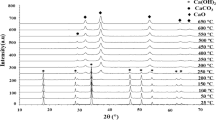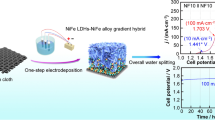Abstract
Biogenic hydroxyapatite (NHAp) was prepared by calcination of waste pork bones and investigated as catalytic support for Ni and Cu metals in the water–gas shift (WGS) reaction. Part of the doped Cu was ion exchanged with Ca ions in the NHAp structure. Also, XPS data showed that after Cu doping, nickel d-hole density increased due to adjacent Cu atoms. Upon reduction, Ni–Cu alloying was detected. For an ideal mixture (CO/H2O: 1/2 in vol%), the monometallic Cu assay was WGS inactive, whereas 10Ni/NHAp was the most active. However, under reformer outlet stream conditions (CO/H2O/CO2/H2/He = 5/46/4/31/14, in vol%), the catalyst 10Ni/NHAp showed negative H2 yield (net hydrogen consumption), whereas selectivity and yield to H2 by Cu-doped bimetallic catalysts reached up to 93% and 26%, respectively. Interestingly, the band-gap energy of these catalysts decreased in line with methane suppression capability (10Ni/NHAp ≫ 7.5Ni2.5Cu/NHAp > 2.5Ni2.5Cu/NHAp > 10Cu/NHAp). Long duration catalytic tests revealed that NHAp derived from pork bone can provide good stability for the WGS reaction, with negligible carbon deposition.
Graphical abstract








Similar content being viewed by others
References
Damen K, van Troost M, Faaij A, Turkenburg W (2006) A comparison of electricity and hydrogen production systems with CO2 capture and storage. Part A: review and selection of promising conversion and capture technologies. Prog Energy Combust 32:215–246
Ruettinger W, Liu XS, Farrauto RJ (2006) Mechanism of aging for a Pt/CeO2–ZrO2 water–gas shift catalyst. Appl Catal B Environ 65:135–141
Newsome DS (1980) The water–gas shift reaction. Catal Rev 21:275–318
Ratnasamy C, Wagner JP (2009) Water gas shift catalysis. Catal Rev 51:325–440
Nisar J, Razaq R, Farooq M, Iqbal M, Ali Khan R, Sayed M, Shah A, Rahman I (2017) Enhanced biodiesel production from Jatropha oil using calcined waste animal bones as catalyst. Renew Energy 101:111–119
Sebti S, Tahir R, Nazih R, Saber A, Boulaajaj S (2002) Hydroxyapatite as a new solid support for the Knoevenagel reaction in heterogeneous media without solvent. Appl Catal A Gen 228:155–159
Domínguez MI, Romero-Sarria F, Centeno MA, Odriozola JA (2009) Gold/hydroxyapatite catalysts: synthesis, characterization and catalytic activity to CO oxidation. Appl Catal B Environ 87:245–251
Uskoković V (2015) The role of hydroxyl channel in defining selected physicochemical peculiarities exhibited by hydroxyapatite. RSC Adv 5:36614–36633
Elkabouss K, Kacimi M, Ziyad M, Ammar S, Bozon-Verduraz F (2004) Cobalt-exchanged hydroxyapatite catalysts: magnetic studies, spectroscopic investigations, performance in 2-butanol and ethane oxidative dehydrogenations. J Catal 226:16–24
Miao D, Cavusoglu G, Lichtenberg H, Yu J, Xu H, Grunwaldt JD, Goldbach A (2017) Water–gas shift reaction over platinum/strontium apatite catalysts. Appl Catal B Environ 202:587–596
Silvester L, Lamonier JF, Vannier RN, Lamonier C, Capron M, Mamede AS, Pourpoint F, Gervasini A, Dumeignil F (2014) Structural, textural and acid–base properties of carbonate-containing hydroxyapatites. J Mater Chem A 2:11073–11090
Venugopal A, Scurrell MS (2003) Hydroxyapatite as a novel support for gold and ruthenium catalysts: behaviour in the water gas shift reaction. Appl Catal A Gen 245:137–147
Boukha Z, Ayastuy JL, González-Velasco JR, Gutiérrez-Ortiz MA (2017) CO elimination processes over promoter-free hydroxyapatite supported palladium catalysts. Appl Catal B Environ 201:189–201
Kaneda K, Mizugaki T (2009) Development of concerto metal catalysts using apatite compounds for green organic syntheses. Energy Environ Sci 2:655–673
Marrakchi F, Ahmed MJ, Khanday WA, Asif M, Hameed BH (2017) Mesoporous carbonaceous material from fish scales as low-cost adsorbent for reactive orange 16 adsorption. J Taiwan Inst Chem Eng 71:47–54
Grunenwald A, Keyser C, Sautereau AM, Crubezy E, Ludes B, Drouet C (2014) Revisiting carbonate quantification in apatite (bio)minerals: a validated FTIR methodology. J Arch Sci 49:134–141
El Haddad M, Slimani R, Mamouni R, Laamari MR, Rafqah S, Lazar S (2013) Evaluation of potential capability of calcined bones on the biosorption removal efficiency of safranin as cationic dye from aqueous solutions. J Taiwan Inst Chem Eng 44:13–18
Smith SM, Oopathum C, Weeramongkhonlert V, Smith CB, Chaveanghong S, Ketwong P, Boonyuen S (2013) Transesterification of soybean oil using bovine bone waste as new catalyst. Bioresour Technol 143:686–690
Iriarte-Velasco U, Ayastuy JL, Boukha Z, Bravo R, Gutiérrez-Ortiz MA (2018) Transition metals supported on bone-derived hydroxyapatite as potential catalysts for the water–gas shift reaction. Renew Energy 115:641–648
Abd El-Moemen A, Kučerová G, Behm RJ (2010) Influence of H2, CO2 and H2O on the activity and deactivation behavior of Au/CeO2 catalysts in the water gas shift reaction at 300 °C. Appl Catal B Environ 95:57–70
Ma L, Ma H, Han D, Qiu M, Guan Y, Hu Y (2018) Evolution of copper supported on Fe3O4 nanorods for WGS reaction. Catalysts 8(10):415. https://doi.org/10.3390/catal8100415
Boukha Z, Ayastuy JL, González-Velasco JR, Gutiérrez-Ortiz MA (2018) Water-gas shift reaction over a novel Cu-ZnO/HAP formulation: enhanced catalytic performance in mobile fuel cell applications. Appl Catal A Gen 566:1–14
Wang T, Dorner-Reisel A, Müller E (2004) Thermogravimetric and thermokinetic investigation of the dehydroxylation of a hydroxyapatite powder. J Eur Ceram Soc 24:693–698
Yasukawa A, Kandori K, Ishikawa T (2003) TPD–TG–MS study of carbonate calcium hydroxyapatite particles. Calcif Tissue Int 72:243–250
Iriarte-Velasco U, Ayastuy JL, Zudaire L, Sierra I (2014) An insight into the reactions occurring during the chemical activation of bone char. Chem Eng J 251:217–227
Achchar M, Lamonier C, Ezzamarty A, Lakhdar M, Leglise J, Payen E (2009) New apatite-based supports prepared by industrial phosphoric acid for HDS catalyst synthesis. CR Chim 12:677–682
Rey C, Combes C, Christophe D, Grossin D (2011) Bioactive ceramics: physical chemistry. In: Ducheyne P, Healy KE, Hutmacher DW, Grainger DW, Kirkpatrick CJ (eds) Comprehensive biomaterials. Elsevier, Amsterdam, pp 187–221
Madupalli H, Pavan B, Tecklenburg MMJ (2017) Carbonate substitution in the mineral component of bone: discriminating the structural changes, simultaneously imposed by carbonate in A and B sites of apatite. J Solid State Chem 255:27–35
Corami A, Mignardi S, Ferrini V (2008) Cadmium removal from single- and multi-metal (Cd+Pb+Zn+Cu) solutions by sorption on hydroxyapatite. J Colloid Interface Sci 317:402–408
Belik AA, Naumov P, Kim J, Tsuda S (2011) Low-temperature structural phase transition in synthetic libethenite Cu2PO4OH. J Solid State Chem 184:3128–3133
Tonegawa T, Ikoma T, Yoshioka T, Hanagata N, Tanaka J (2010) Crystal structure refinement of A-type carbonate apatite by X-ray powder diffraction. J Mater Sci 45:2419–2426. https://doi.org/10.1007/s10853-010-4209-x
Jha A, Jeong DW, Shim JO, Jang WJ, Lee YL, Rode CV, Roh HS (2015) Hydrogen production by the water–gas shift reaction using CuNi/Fe2O3 catalyst. Catal Sci Technol 5:2752–2760
Matsunaga K, Kuwabara A (2007) First-principles study of vacancy formation in hydroxyapatite. Phys Rev B 75:014102–014110
Chen C, Zhou Y, Wang N, Cheng L, Ding H (2015) Cu2(OH)PO4/g-C3N4 composite as an efficient visible light-activated photo-Fenton photocatalyst. RSC Adv 5:95523–95531
Song L, Cao X, Li L (2018) Engineering stable surface oxygen vacancies on ZrO2 by hydrogen-etching technology: an efficient support of gold catalysts for water–gas shift reaction. ACS Appl Mater Interfaces 10:31249–31259
Molina R, Poncelet G (1999) α-Alumina-supported nickel catalysts prepared with nickel acetylacetonate. 2. A study of the thermolysis of the metal precursor. J Phys Chem B 103:11290–11296
Rodriguez NM, Kim MS, Baker RTK (1993) Deactivation of copper nickel-catalysts due to changes in surface composition. J Catal 140:16–29
Gonzalez-Elipe AR, Munuera G, Espinos JP (1990) XPS intensities and binding energy shifts as metal dispersion parameters in Ni/SiO2 catalysts. Surf Interface Anal 16:375–379
Naghash AR, Etsell TH, Xu S (2006) XRD and XPS study of Cu−Ni interactions on reduced copper−nickel−aluminum oxide solid solution catalysts. Chem Mater 18:2480–2488
Lee SY, Mettlach N, Nguyen N, Sun YM, White JM (2003) Copper oxide reduction through vacuum annealing. Appl Surf Sci 206:102–109
Boukha Z, Ayastuy JL, Cortés-Reyes M, Alemany LJ, González-Velasco JR, Gutiérrez-Ortiz MA (2019) Catalytic performance of Cu/hydroxyapatite catalysts in CO preferential oxidation in H2-rich stream. Int J Hydrogen Energy 44:12649–12660
Roh H, Jun K, Dong W, Park S, Joe Y (2001) Partial oxidation of methane over Ni/θ-Al2O3 catalysts. Chem Lett 7:666–667
Prins R (2012) Hydrogen spillover. Facts and fiction. Chem Rev 112:2714–2738
Jun JH, Lee TJ, Lim TH, Nam SW, Hong SA, Yoon KJ (2004) Nickel–calcium phosphate/hydroxyapatite catalysts for partial oxidation of methane to syngas: characterization and activation. J Catal 221:178–190
Chen LF, Guo PJ, Zhu LJ, Qiao MH, Shen W, Xu HL, Fan KN (2009) Preparation of Cu/SBA-15 catalysts by different methods for the hydrogenolysis of dimethyl maleate to 1,4-butanediol. Appl Catal A Gen 356:129–136
Aguila G, Valenzuela A, Guerrero S, Araya P (2013) WGS activity of a novel Cu–ZrO2 catalyst prepared by a reflux method. Comparison with a conventional impregnation method. Catal Commun 39:82–85
Qu Y, Sun D, Chen Y, Wang Y (2014) Possible sites of copper located on hydroxyapatite structure and the identification of active sites for formaldehyde oxidation. J Mol Catal A Chem 393:182–190
Tounsi H, Djemal S, Petitto C, Delahay G (2011) Copper loaded hydroxyapatite catalyst for selective catalytic reduction of nitric oxide with ammonia. Appl Catal B Environ 107:158–163
Jemal J, Tounsi H, Chaari K, Petitto C, Delahay G, Djemel S, Ghorbel A (2012) NO reduction with NH3 under oxidizing atmosphere on copper loaded hydroxyapatite. Appl Catal B Environ 113–114:255–260
Dragoi B, Ungureanu A, Chirieac A, Ciotonea C, Rudolf C, Royer S, Dumitriu E (2015) Structural and catalytic properties of mono- and bimetallic nickel–copper nanoparticles derived from MgNi(Cu)Al-LDHs under reductive conditions. Appl Catal A Gen 504:92–102
Chen CS, Lin JH, Lai TW, Li BH (2009) Active sites on Cu/SiO2 prepared using the atomic layer epitaxy technique for a low-temperature water–gas shift reaction. J Catal 263:155–166
Shi D, Wojcieszak R, Paul S, Marceau E (2019) Ni promotion by Fe: what benefits for catalytic hydrogenation? Catalysts 9:451–478
Ang ML, Oemar U, Saw ET, Mo L, Kathiraser Y, Chia BH, Kawi S (2014) Highly active Ni/xNa/CeO2 catalyst for the water gas shift reaction: effect of sodium on methane suppression. ACS Catal 4:3237–3248
Kopyscinski J, Schildhauer TJ, Vogel F, Biollaz SMA, Wokaun A (2010) Applying spatially resolved concentration and temperature measurements in a catalytic plate reactor for the kinetic study of CO methanation. J Catal 271:262–279
Gokhale AA, Dumesic JA, Mavrikakis M (2008) On the mechanism of low-temperature water gas shift. J Am Chem Soc 130:1402–1414
Huang SC, Lin CH, Wang JH (2010) Trends of water gas shift reaction on close packed transition metal surfaces. J Phys Chem C 114:9826–9834
Schumacher N, Boisen A, Dahl S, Gokhale A, Kandoi S, Grabow L et al (2005) Trends in low-temperature water–gas shift reactivity on transition metals. J Catal 229:265–275
van de Loosdrecht J, van der Kraan AM, van Dillen AJ, Geus JW (1997) Potassium-promoted titania-supported nickel–iron catalysts for Fischer–Tropsch synthesis. J Catal 170:217–226
Lim JY, McGregor J, Sederman AJ, Dennis JS (2016) The role of the Boudouard and water–gas shift reactions in the methanation of CO or CO2 over Ni/γ-Al2O3 catalyst. Chem Eng Sci 152:754–766
Acknowledgements
The financial support for this work provided by the Spanish Ministry of Economy and Competitiveness/Ministerio de Economía y Competitividad (ENE2016-74850-R) and the Basque Government/Gobierno Vasco (GV-2018-00038) is gratefully acknowledged. The authors also wish to express their gratitude for the technical and human support provided by SGIker of the UPV/EHU.
Author information
Authors and Affiliations
Corresponding author
Additional information
Handling Editor: Catalin Croitoru.
Publisher's Note
Springer Nature remains neutral with regard to jurisdictional claims in published maps and institutional affiliations.
Supplementary Information
Below is the link to the electronic supplementary material.
Rights and permissions
About this article
Cite this article
Iriarte-Velasco, U., Ayastuy, J.L., Bravo, R. et al. Biogenic hydroxyapatite as novel catalytic support for Ni and Cu for the water–gas shift reaction. J Mater Sci 56, 6745–6763 (2021). https://doi.org/10.1007/s10853-020-05724-x
Received:
Accepted:
Published:
Issue Date:
DOI: https://doi.org/10.1007/s10853-020-05724-x




